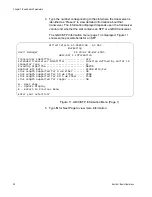
Chapter 1: Basic Switch Parameters
46
Section I: Basic Operations
Configuring the Console Timer
The AT-S63 Management Software uses the console timer, also referred
to as the console disconnect interval, to automatically end inactive local
and remote management sessions. The management software
automatically ends a local or remote management session if a
management session is inactive for the length of time specified by the
console timer. For example, if you specify two minutes as the console
timer, the AT-S63 Management Software automatically ends a
management session if it does not detect any activity from the local or
remote management station after two minutes.
This security feature prevents unauthorized individuals from using your
management station when you step away from your system while you are
configuring a switch. The default for the console timeout value is 10
minutes.
To adjust the console timer, perform the following procedure:
1. From the Main Menu, type
5
to select System Administration.
The System Administration menu is shown in Figure 1 on page 32.
2. From the System Administration menu, type
3
to select Console
(Serial/Telnet) Configuration.
The Console (Serial/Telnet) Configuration menu is shown in Figure 7
on page 45.
3. From the Console (Serial/Telnet) Configuration menu, type
2
to select
Console Disconnect Interval
The following prompt is displayed:
Enter your new value -> [1 to 60]->
4. Enter a new console timer value. The range is 1 to 60 minutes. The
default is 10 minutes.
A change to the console timer is immediately activated on the switch.
5. After making changes, type
R
until you return to the Main Menu. Then
type
S
to select Save Configuration Changes.
Summary of Contents for AT-9400
Page 16: ...Figures 16 ...
Page 18: ...Tables 18 ...
Page 28: ...Preface 28 ...
Page 30: ...30 Section I Basic Operations ...
Page 60: ...Chapter 1 Basic Switch Parameters 60 Section I Basic Operations ...
Page 64: ...Chapter 2 Port Parameters 64 Section I Basic Operations Port Type The port type ...
Page 84: ...Chapter 2 Port Parameters 84 Section I Basic Operations ...
Page 124: ...Chapter 6 Static Port Trunks 124 Section I Basic Operations ...
Page 144: ...144 Section II Advanced Operations ...
Page 196: ...Chapter 10 File Downloads and Uploads 196 Section II Advanced Operations ...
Page 218: ...Chapter 11 Event Logs and the Syslog Client 218 Section II Advanced Operations ...
Page 242: ...Chapter 13 Access Control Lists 242 Section II Advanced Operations ...
Page 294: ...294 Section III IGMP Snooping MLD Snooping and RRP Snooping ...
Page 314: ...Chapter 19 MLD Snooping 314 Section III IGMP Snooping MLD Snooping and RRP Snooping ...
Page 318: ...318 Section IV SNMPv3 ...
Page 416: ...Chapter 21 SNMPv3 416 Section IV SNMPv3 ...
Page 418: ...418 Section V Spanning Tree Protocols ...
Page 470: ...470 Section VI Virtual LANs ...
Page 520: ...Chapter 26 Multiple VLAN Modes 520 Section VI Virtual LANs ...
Page 532: ...Chapter 27 Protected Ports VLANs 532 Section VI Virtual LANs ...
Page 546: ...546 Section VII Internet Protocol Routing ...
Page 560: ...560 Section VIII Port Security ...
Page 568: ...Chapter 30 MAC Address based Port Security 568 Section VIII Port Security ...
Page 586: ...Chapter 31 802 1x Port based Network Access Control 586 Section VIII Port Security ...
Page 588: ...588 Section IX Management Security ...
Page 610: ...Chapter 33 Encryption Keys 610 Section IX Management Security ...
Page 650: ...Chapter 36 TACACS and RADIUS Protocols 650 Section IX Management Security ...
Page 660: ...Chapter 37 Management Access Control List 660 Section IX Management Security ...
Page 668: ...Index 668 ...






























